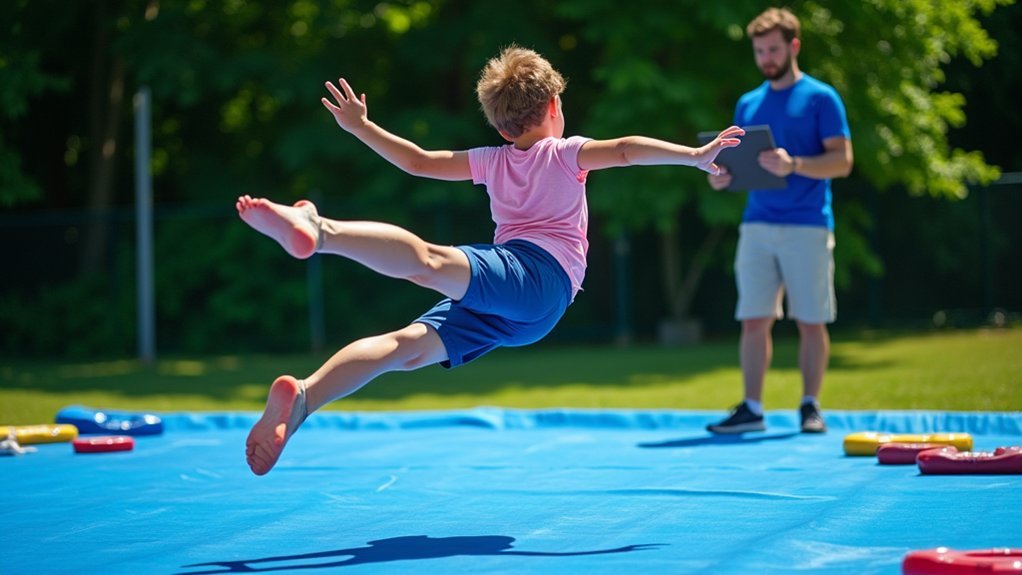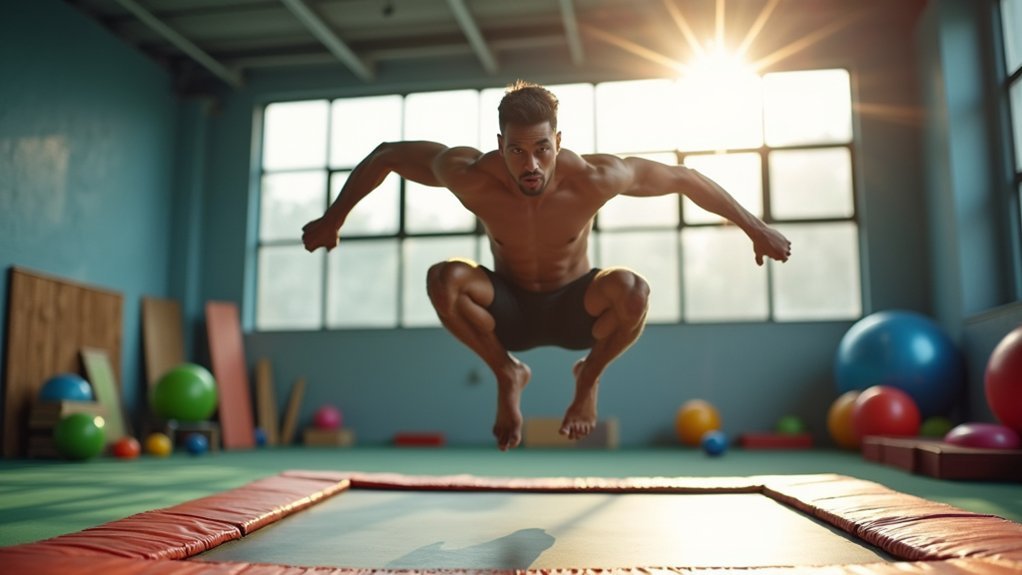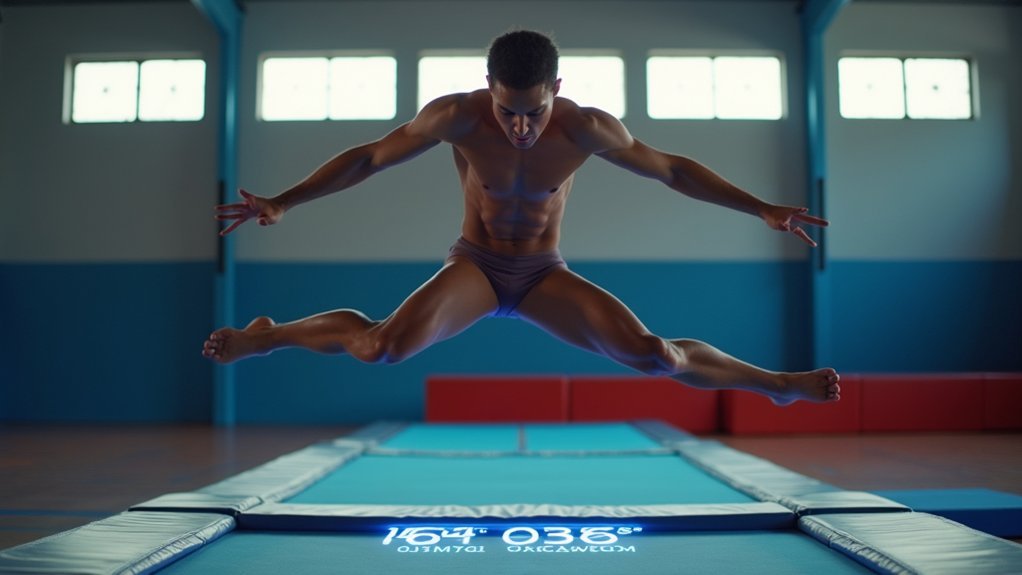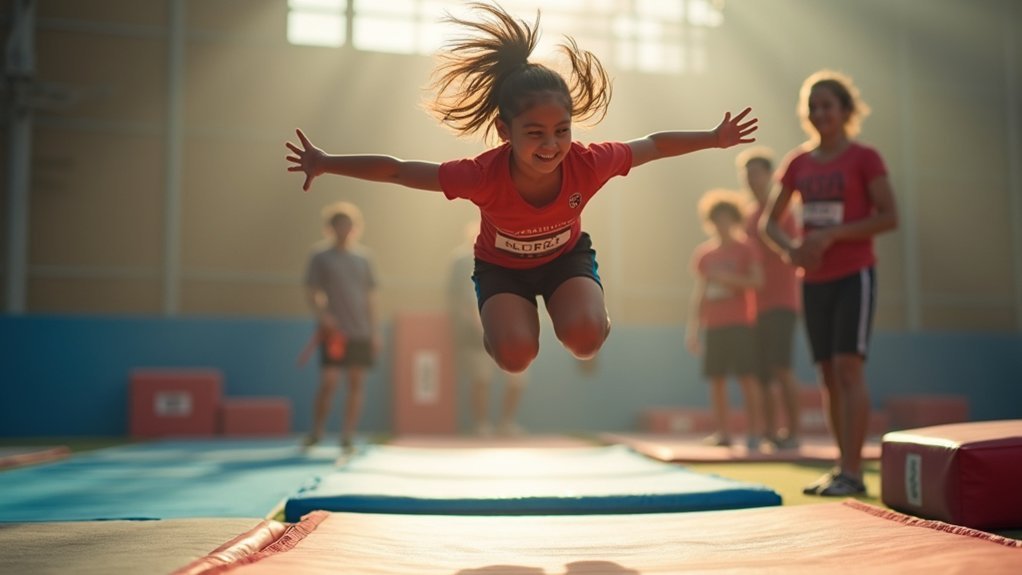Trampoline training dramatically improves athletic balance through controlled instability. You’ll strengthen your proprioceptive system while engaging core and stabilizing muscles with low-impact, dynamic movements. Start with basic stability exercises like single-leg stands and heel-to-toe walking before progressing to sport-specific techniques and rotational control drills. Add resistance bands and dual-task challenges as you advance. Proper equipment and safety protocols guarantee you’ll maximize balance gains while minimizing injury risks.
The Science Behind Trampoline Balance Training

While most people view trampolines as recreational equipment, they’re actually powerful training tools backed by scientific research. Each bounce creates dynamic gravitational shifts that force your body to constantly readjust, greatly improving proprioception—your body’s awareness of its position in space.
Studies using mini-trampolines have documented remarkable improvements in balance and functional mobility over just 12 weeks of training. This happens because trampoline exercises simultaneously engage multiple muscle groups while challenging your vestibular system. The 2011 study demonstrates significant improvements in balance and motor control across participants of various fitness levels.
Research confirms that trampoline workouts revolutionize balance by engaging multiple muscle systems while stimulating vestibular adaptation.
Your core, legs, and stabilizing muscles work overtime to maintain equilibrium on the unstable surface.
For enhanced balance development, incorporate tennis balls or thera bands into your routine. These tools increase difficulty and create new balance challenges that translate to better coordination and posture in everyday movements.
Essential Equipment for Athletic Balance Drills
When selecting a mini trampoline for balance training, you’ll want to take into account factors like weight capacity, spring tension, and frame stability to match your specific workout needs.
Your safety gear should include ankle supports for joint protection and stabilizing handrails if you’re just starting out or attempting advanced movements.
Choose footwear with minimal cushioning but adequate arch support to maximize proprioceptive feedback while maintaining proper foot alignment during your bouncing exercises.
Adding a wobble cushion to your trampoline routine can effectively engage your lower back and core for enhanced balance stability, especially during recovery periods between jumping intervals.
Mini Trampolines Matter
Since athletic performance hinges on balance and stability, mini trampolines have emerged as essential equipment for balance training. These portable, cost-effective devices offer low-impact training while requiring constant muscle adjustments that enhance proprioception and dynamic balance. Outdoor settings like the one in Carefree, Arizona can provide an ideal environment for these balance drills.
- Versatility at its finest – Incorporate tennis balls, thera bands, and balloons to increase difficulty and target specific athletic skills while engaging multiple muscle groups simultaneously.
- Progressive training potential – Easily adjust intensity by modifying jump height or adding weights, allowing athletes to advance from basic to complex movements.
- Group-friendly format – Conduct small group sessions with personalized supervision, making these tools ideal for athletes of various ages and abilities, including seniors and those with mobility limitations.
Safety Gear Considerations
Every athletic trampoline training program requires thorough safety equipment to protect participants from potential injuries. Invest in high-density PE foam mats and wedge-shaped safety pads that allow quick adaptation between different setups. The JumpSport Training Bag with its UV-resistant materials offers excellent protection for athletes practicing extreme sports maneuvers on trampolines.
Your facility must include 150 PSI-rated nets with seamless designs to prevent limb entrapment.
Don’t compromise on supervision protocols – maintain 1:1 supervision ratios for complex maneuvers and install proper harness systems for practicing flips. Enforce a strict single-user policy to eliminate collision risks, and conduct pre-jump inspections to verify mat integrity and spring tension.
Position first-aid kits within 10-second access of all training areas and implement specific concussion protocols. Install non-slip surfaces around your trampoline’s perimeter and guarantee AED accessibility meets cardiac event response standards.
Supportive Footwear Selection
Choosing the right footwear for trampoline training directly impacts your balance, performance, and safety during athletic drills.
Opt for shoes with excellent grip and traction to prevent slips while maintaining stability during dynamic movements.
Your ideal trampoline footwear should balance support with flexibility, allowing natural foot movement while protecting joints during repetitive impacts.
Lightweight, breathable materials will enhance your agility and prevent discomfort during intense sessions.
Avoid running or cross-training shoes with thick, cushioned soles as they create serious instability on the rebounding surface.
- Flat-soled options like wrestling or tennis shoes provide stability without damaging the trampoline surface.
- Trampoline-specific shoes offer superior grip and control, ideal for competitive athletes.
- Barefoot training enhances proprioception and strengthens foot muscles, though may cause fatigue during extended sessions.
Beginner Balance Challenges for New Athletes
When new athletes first step onto a trampoline, they’ll quickly discover that balance isn’t just helpful—it’s essential.
Start by strengthening your core through simple planks and leg muscles with basic squats to establish fundamental stability.
Begin with slow, controlled movements on the trampoline, focusing on single-leg stances for short durations.
Implementing the single-leg balance exercise is excellent preparation for trampoline training, as it develops the stabilizing muscles needed for bouncing activities.
Practice heel-to-toe walking across the trampoline surface to develop proprioception—your body’s awareness of its position in space.
Incorporate resistance bands for gentle challenges once you’ve mastered the basics.
A BOSU ball or foam pad placed on stable ground can prepare you for the unpredictable surface of a trampoline.
Always guarantee a safe environment with proper spotting and clear surroundings, gradually increasing difficulty as your confidence grows.
Advanced Instability Exercises for Elite Performance

You’ll reach new levels of performance with multi-axis balance challenges that test your stability from every angle.
Progressive destabilization techniques, such as combining BOSU balls with trampoline work or adding ankle weights during single-leg stance exercises, force your body to adapt to increasingly unpredictable environments. Incorporating eyes-closed exercises during trampoline work significantly enhances proprioception and balance.
Multi-Axis Balance Challenges
While basic trampoline skills build fundamental stability, multi-axis balance challenges represent the frontier of elite performance training.
These advanced drills force your body to make rapid adjustments along multiple planes simultaneously, enhancing proprioceptive pathways and core stabilization. Integrating rocker profile exercises also enhances this multi-directional stability training significantly.
- Dynamic weight-shifting – Execute lateral and anterior-posterior movements mid-air, constantly forcing your neuromuscular system to adapt to the trampoline’s destabilizing effect.
- Rotational control protocols – Practice single-axis jumps with 360° rotations while maintaining strict shoulder alignment, mimicking figure skating axels.
- Reactive perturbation training – Incorporate partner-assisted pushes or sudden directional changes mid-jump to develop faster error correction and adaptive postural responses.
These challenges optimize three-dimensional joint loading while improving your ability to manipulate your center of gravity through continuous vertical oscillations.
Progressive Destabilization Techniques
Progressive destabilization techniques represent the pinnacle of trampoline training methodology, designed specifically to challenge even the most advanced athletes through systematic exposure to increasingly complex instability scenarios.
You’ll master double-back skills with considerably reduced injury risk compared to floor training. Combine trampoline work with progressive resistance exercises to maximize strength gains while maneuvering unstable surfaces.
Create dynamic movement combinations by sequencing jumps, hops, and lateral movements for heightened difficulty. Implement dual-task exercises that engage both cognitive and motor functions simultaneously, forcing your body to adapt to extreme destabilization.
These advanced techniques enhance your balance capabilities, strength, and adaptability while minimizing injury potential. Maintaining low and controlled posture throughout your trampoline exercises maximizes core strength development and overall health benefits.
As you progress, customize your training intensity based on individual proficiency, gradually introducing more complex variations that prepare you for elite athletic performance in any environment.
Sport-Specific Trampoline Balance Techniques
Developing specialized balance techniques on the trampoline can dramatically enhance performance in various sports. By incorporating sport-specific movements into your trampoline routine, you’ll build transferable skills that directly improve your athletic ability.
- Surfer’s Stance – Practice the staggered stance with torso rotation and counterbalance arm movements to develop better balance for board sports. Engage your obliques during this “surf twist” to strengthen core stability.
- Rapid Direction Changes – Perform scissor moves and dynamic twists to improve your reaction time for sports like tennis and basketball, where quick balance adjustments are essential. Tuck jumps can be incorporated to develop explosive strength needed for quick directional adjustments in competitive sports.
- Weight Shift Mastery – Work on shifts between centered stance and staggered foot positions while maintaining proper shoulder alignment to enhance the stability needed in sports requiring precise weight distribution.
Measuring Balance Improvements With Metrics

Tracking your balance progression through specific metrics provides a concrete way to assess improvement in your trampoline training regimen. Combine quantitative data (like successful jump counts) with qualitative feedback about perceived stability to create a thorough assessment.
Implement both success metrics that directly measure balance goals and counter metrics that identify potential negative effects on other performance areas. This balanced approach guarantees your training enhances overall athletic performance without creating new weaknesses.
Balance your tracking with both success and counter metrics to ensure holistic athletic development without sacrificing performance.
Use technology like wearable devices to capture precise measurements, while establishing regular feedback loops to catch and address issues early. Effective metrics for trampoline training should be SMART and relevant, ensuring you’re tracking the factors that truly indicate progress in balance development. Stratify your data to identify specific areas needing attention, and continuously monitor progress over time to guarantee sustained improvement.
Remember that effective metrics should track both the process (training adherence) and outcomes (performance improvements).
Injury Prevention Through Controlled Instability
The paradox of trampoline training lies in its controlled instability—a feature that both challenges athletes and protects them from injury when properly managed.
This dynamic environment enhances your body’s coordinative responses and balance recovery mechanisms, fundamentally teaching you how to fall safely in real-world situations.
To maximize safety while leveraging instability:
- Always land with bent knees to absorb impact and maintain balance, starting with low-intensity exercises before progressing to more challenging movements.
- Confirm proper setup with non-slip surfaces, safety padding, and stability bars for entry/exit support.
- Incorporate regular rest days between your 2-3 weekly sessions, beginning with 10-15 minute workouts while your body adapts to this unique training method.
For long-term injury prevention and optimal performance, consider investing in a trampoline with sturdy frames and heavier weight construction that won’t compromise your safety during intensive workouts.
Creating a Progressive Balance Training Program
When you commence a progressive balance training program with trampolines, systematic advancement becomes your pathway to meaningful results.
Begin with simple marching movements, gradually incorporating side-to-side steps as your confidence builds.
To maximize benefits, schedule regular sessions that increase in duration over time. Start with 10-minute workouts and work up to 20-30 minutes as your endurance improves. The patented arched legs design provides exceptional stability during these increasingly challenging balance exercises.
Challenge yourself by adding one-leg lifts, heel raises, and eventually one-leg squats.
For seniors or those with disabilities, mini-trampolines with handrails provide ideal safety while still delivering effective training.
Remember to engage your core throughout each exercise, as this strengthens your balance foundation.
Combining Trampoline Work With Other Balance Modalities
Maximizing your balance training potential requires looking beyond the trampoline alone. By integrating complementary equipment and techniques, you’ll develop more thorough stability skills that transfer effectively to your sport of choice.
- BOSU Ball Integration – Alternate between trampoline sessions and BOSU ball exercises to challenge your stability in different ways, strengthening your core and improving proprioception through varied unstable surfaces.
- Balance Board Circuits – Create circuits that move from trampoline drills to balance board work, enhancing your agility while diversifying the balance challenges your neuromuscular system must overcome. Training with one leg standing while engaging your core muscles significantly improves proprioceptive awareness that transfers to all balance activities.
- Yoga-Trampoline Fusion – Incorporate yoga poses between trampoline sets to increase flexibility and mindful control, allowing for better body awareness and refined balance during dynamic movements.
Frequently Asked Questions
How Long Before Competition Should Athletes Stop Trampoline Training?
You should taper your trampoline training 1-2 weeks before competition, reducing intensity while still performing maintenance skills. Shift focus to mental preparation rather than physical training for peak performance.
Can Trampoline Training Negatively Impact Existing Joint Conditions?
Yes, trampoline training can worsen existing joint conditions if you’re not careful. You’ll need to modify exercises, use proper technique, and consult your doctor first. Start slowly and stop if you feel pain.
What Age Is Appropriate to Begin Athletic Trampoline Balance Training?
You can start your child on trampoline balance training around age 3-6, depending on their motor skills. You’ll need to supervise young children closely and choose age-appropriate equipment for safety.
Are Outdoor Trampolines Effective for Professional Balance Training?
Yes, outdoor trampolines can be effective for professional balance training if you’re using quality equipment and following proper techniques. You’ll need to take into account weather constraints and make sure you’ve installed appropriate safety features.
How Does Altitude Affect Trampoline Training Benefits?
Altitude affects your trampoline training by reducing oxygen and air density. You’ll jump higher with less resistance, but you’ll fatigue faster. You’ll need shorter sessions and must adjust for slower recovery times.
In Summary
You’ve now discovered how trampolines can transform your athletic balance training. By incorporating these progressive drills into your routine, you’ll develop proprioception that transfers directly to your sport. Remember to measure your improvements, prioritize safety, and combine trampoline work with complementary modalities. Whether you’re a beginner or elite athlete, these unstable surface challenges will elevate your performance to new heights. Start bouncing, start balancing!





Leave a Reply